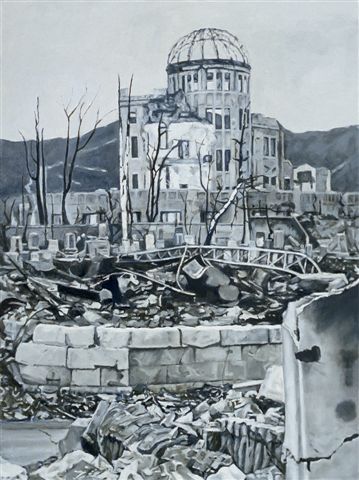Above is an artist’s depiction of the Hiroshima Peace Memorial (Genbaku Dome or A-Bomb Dome), the only structure left standing in the area where the atomic bomb exploded. It has been preserved in the same state as immediately after the bombing. Painting by Toki Ouri.
In August, 1945, after 6 months of firebombing attacks on 67 Japanese cities, US President Harry Truman ordered the atomic bombing of Hiroshima (August 6) and Nagasaki (August 9). The death toll was enormous – 140,000 in Hiroshima and 80,000 in Nagasaki by the end of 1945. Many more thousands died over the months and years to come from injuries and illnesses caused by radiation poisoning.
For many years, Winnipeggers have joined the citizens of Hiroshima and from around the world in commemorating these tragedies and in reaffirming our commitment to peace and freedom from nuclear terror. We symbolize our commitment with a Lantern Ceremony.
 The Lantern Ceremony is part of an ancient Buddhist Ceremony (O-Bon), that commemorates the lives of loved ones who have passed away. There is a belief that each year (in July), the spirits of your loved ones come back to celebrate their lives with you. At the end of the festival, lighted lanterns are launched on the river, in a symbolic gesture to assist the spirits of the deceased, a safe journey back to the spiritual world.
The Lantern Ceremony is part of an ancient Buddhist Ceremony (O-Bon), that commemorates the lives of loved ones who have passed away. There is a belief that each year (in July), the spirits of your loved ones come back to celebrate their lives with you. At the end of the festival, lighted lanterns are launched on the river, in a symbolic gesture to assist the spirits of the deceased, a safe journey back to the spiritual world.
For many years around the world, this ceremony has been used on Hiroshima Peace Day, to remember and embrace the memory of innocent people who have perished during the atomic bombing of Hiroshima. During these ceremonies, participants are invited to design a lantern that represents their thoughts and feelings regarding personal losses, global concerns of peace, nuclear disarmament and any other issues relevant to keeping our planet safe.
Lanterns for Peace
In Winnipeg and Brandon, we invite attendees to make a lantern and to make peace cranes (origami).
Many people are familiar with the story of “Sadako and a Thousand Paper Cranes”. Sadako Sasaki, a young girl of 10 years old, became sick with leukemia from the effects of the atomic bomb, in post war Japan. She believed in an ancient tale that if you made 1000 paper cranes, you would be granted a wish. She wished for good health. She died before she completed making the cranes and her classmates completed the task for her. Each year, thousands of paper cranes from all over the world, adorn the statue of Sadako, in the Hiroshima Peace Park, in Hiroshima, Japan.

WINNIPEG
Where: Memorial Park, Winnipeg
When: Wednesday, August 6, 2008
Time: 7:30 PM
BRANDON
The First Annual Japanese Lantern Ceremony for World Peace
Where: Keystone Centre YMCA Pool on 13th Street
When: Wednesday, August 6, 2008
Time: 7:30 PM
Please participate, and invite friends and family. As you can see from the table below, the nuclear threat has not diminished. Even more ominously, the United States is planning an attack on Iran which could include the use of “bunker-buster tactical nuclear weapons.”
You can help promote this event by downloading, printing and posting our Lanterns for Peace poster.
The Nuclear Club
| Country | Warheads active/total* | Year of first test |
|---|---|---|
| Five nuclear weapons states from the Non Proliferation Treaty | ||
| 4,075 / 5,535 | 1945 | |
| 5,830 / 16,000 | 1949 | |
| 200 | 1952 | |
| <350 | 1960 | |
| <160 | 1964 | |
| Other known nuclear powers | ||
| 100-200 | 1974 | |
| 160 | 1998 | |
| 0-10 | 2006 | |
| Undeclared nuclear weapons states | ||
| 100-200 | unknown or 1979 (See Vela Incident) | |
Source: Adapted from Wikipedia




